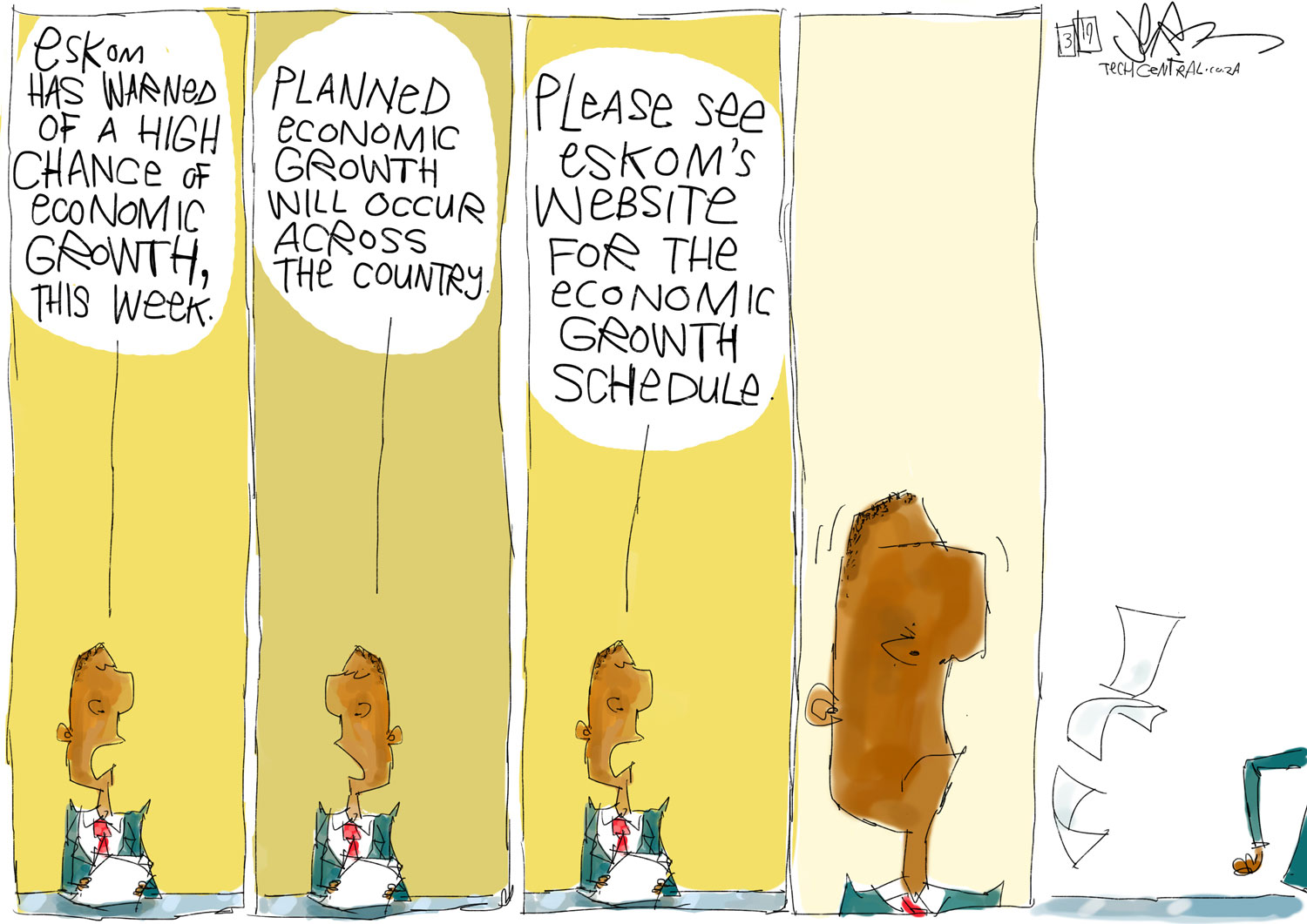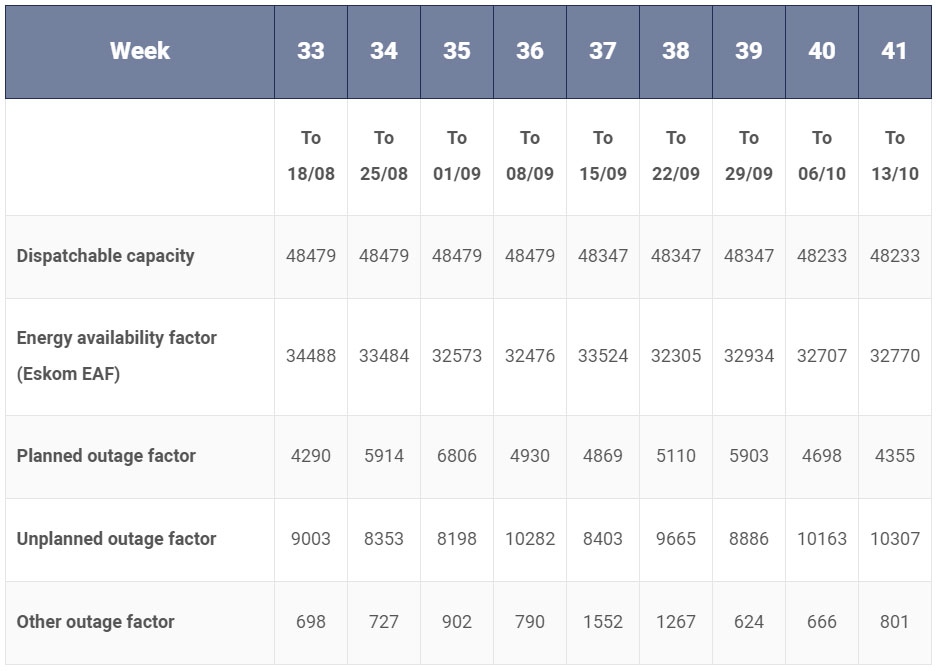 While the immediate causes of the generation crisis at Eskom are well known, the emergency it found itself in this week has been some time coming. The utility and others have confirmed a number of outages, both planned and unplanned.
While the immediate causes of the generation crisis at Eskom are well known, the emergency it found itself in this week has been some time coming. The utility and others have confirmed a number of outages, both planned and unplanned.
These include one unit offline at the Koeberg nuclear power station for refuelling (planned), “five generating units that are unavailable due to boiler tube leaks” and the failure of the coal conveyor at Medupi power station on Saturday, “thus limiting the generating capability to approximately half the station output” (some have suggested the real figure is lower than half).
The decision to implement stage-2 load shedding with very little warning on Wednesday is shocking, given that Eskom admits it has been using “pumped storage and OCGT (open-cycle gas turbine_ generators … extensively” since Saturday. Eventually, diesel and water levels got to the point where these were no longer available options.
The issues predate Saturday, however.
From a peak in April of 72.99%, the utility’s energy availability factor (EAF) has — barring one or two exceptions — steadily deteriorated over the past six months. For the year-to-date, EAF is averaging 67.75%, much lower than the 71.84% achieved last year. This only tells half the story, however, as Eskom always ramps up planned maintenance from spring. In theory, this was to have roughly doubled from the 3/3.5GW level to 6GW from late August. This will, understandably, impact EAF as this plant is not available.

The critical and flawed assumption (base case) in Eskom’s system outlook, which informs the three-month outlook updated weekly, is that unplanned breakdowns will total 8.5GW. This is a not insignificant amount of generation, representing around 16% of its total dispatchable capacity.
Since early April when detailed statistics became available from Eskom, it has managed to keep unplanned outages at below this level for only nine of the 26 weeks (a third of the time). After winter, when planned maintenance was ramped up, unplanned outages were below the 8.5GW level for only three of the nine weeks to last Sunday (13 October).

Complicating matters further is a new metric disclosed by Eskom — the “other outage factor”. Over the 26-week period, this has equated to anything from 535MW (1.12%) to 1 552MW (3.21%).
For the year to date, unplanned outages have averaged 20.83% (versus 15.87% in 2018), while the other outage factor has averaged 1.52% (versus 1.89% in 2018).
Its winter plan, as detailed in the joint briefing by minister of public enterprises Pravin Gordhan and Eskom chair Jabu Mabuza (and Eskom executives) in April, required unplanned maintenance to be under the 9.5GW level. But unplanned outages peaked at 10.9GW in early August and were above 9.5GW for 13 of the 17 weeks since early June!
Even at significantly above the 8.5GW level, however, Eskom has managed to keep the lights on through a combination of:
- Reducing planned maintenance to below originally forecast levels;
- Non-commercial sources (Kusile and Medupi units not yet having achieved commercial operation);
- Renewable supply (excluded from dispatchable generation figures above); and
- Emergency peaking resources (pumped storage and OCGT turbines).
The base case of 8.5GW is therefore wholly unrealistic, especially at this stage.
As this author wrote in April: “The fundamental problem with this plan is that it constructs a reality where Eskom is seemingly able to choose or plan which stage of load shedding to implement. Load shedding is a function of available generation capacity. On any given day, that may change due to hundreds of variables. And sometimes, as happened in mid-March, bad luck arrives all at once.”
This weekend, bad luck again arrived all at once. That it happened during a period when Koeberg is being refuelled (with 930MW offline) is far less than ideal.

In its summer plan, presented on 4 September, Eskom said it needed to execute an average of 5.5GW of planned maintenance. It is simply not managing to do so.
In April, I held that the “next nine months are going to require an almighty effort, day by day, to ensure that plant is not run unnecessarily hard and that the required maintenance gets done in order to keep load shedding from spiralling to stage 4 again. The risks are real.”
Over the next few days, Eskom has to avoid losing control of this situation, failing which we will be right back in the chaos of mid-March, which took three weeks to get out of.
The prognosis for 2020 — especially winter — is going to depend a lot on how much maintenance it is able to conclude over the next five-and-a-half months.
Quick fixes like adding 220MW to its Ingula Pumped Storage Scheme (which it has done) and running a unit from each of Kusile and Medupi hard despite these not yet having achieved commercial operation (which it continues to do) do not solve the underlying problem.
Oh, and a group chief executive might help.
- This article was originally published on Moneyweb and is used here with permission

